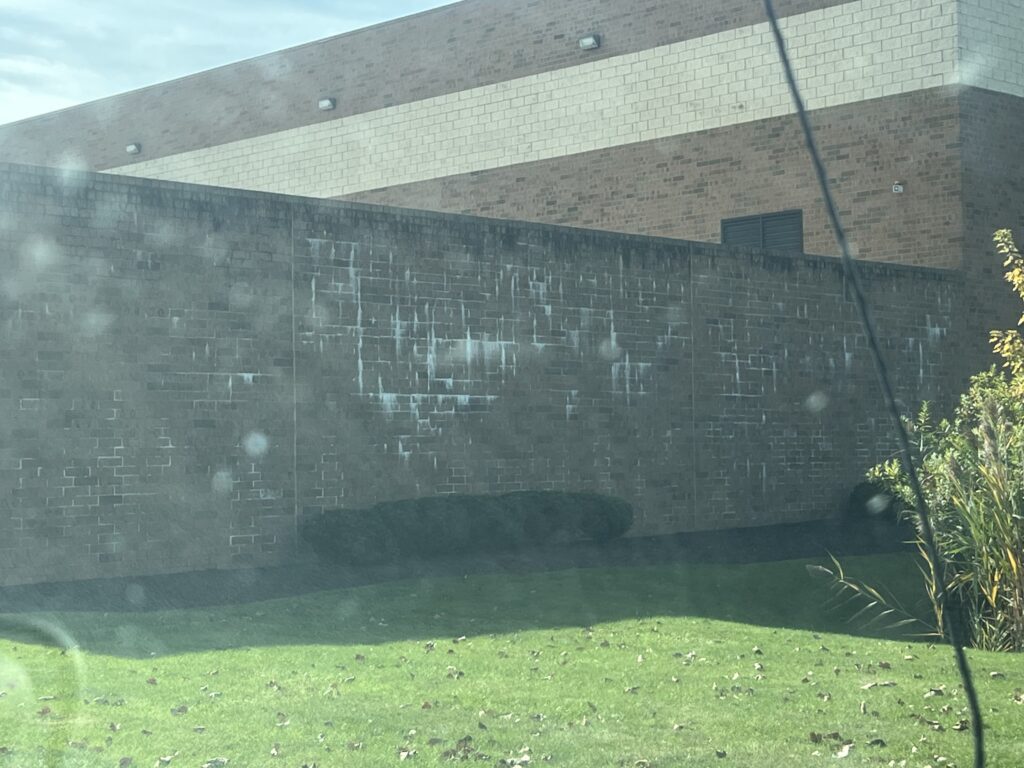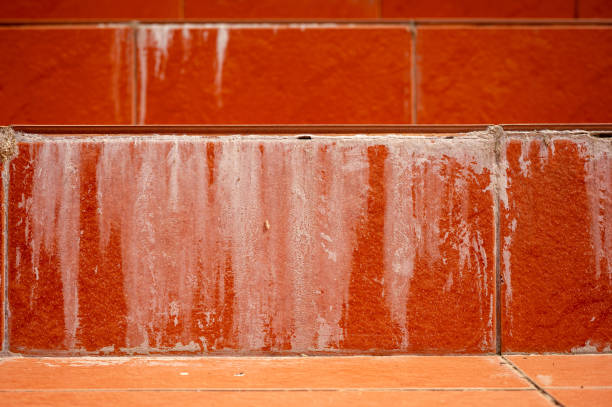Efflorescence on buildings, commonly appearing as a white, powdery residue on brick, concrete, and stone surfaces, is a phenomenon often encountered in both new and older construction. It is not only an aesthetic concern but can also signal potential issues with moisture and structural integrity if left unchecked. Addressing efflorescence and understanding how to effectively remove it is essential for maintaining the appearance and longevity of building materials. This article will delve into the causes and effects of efflorescence, manufacturers’ recommendations, and the role of professional building washing in mitigating this issue.

Understanding Efflorescence
Efflorescence occurs when water-soluble salts within a building material or the surrounding environment migrate to the surface. When moisture moves through porous materials like brick, concrete, or stone, it dissolves these salts, carrying them to the exterior surface. As the water evaporates, the salts crystallize, leaving behind the characteristic white or sometimes light gray deposits.
The salts responsible for efflorescence can come from various sources:
- Materials in the structure: Cement, mortar, brick, and other construction materials often contain salts, including calcium sulfate, sodium sulfate, and potassium sulfate.
- Environmental sources: Soil, groundwater, and rainwater can introduce additional salts.
- Contamination: De-icing salts, fertilizers, and other nearby chemical agents can also contribute to the salt content, particularly on lower building levels and in areas with heavy landscaping.
While efflorescence itself does not damage structural integrity, it can signal moisture problems that may eventually lead to structural issues if not managed. Over time, trapped moisture can freeze and expand within materials, leading to spalling, cracking, and even weakening of the substrate.
Causes of Efflorescence
Efflorescence results from a combination of factors, including moisture, salts, and porosity of building materials. Here are key contributors:
- High Moisture Levels: Efflorescence often appears after heavy rainfall or when water is able to penetrate a structure through small cracks or porous materials. In some cases, improper drainage around a building can exacerbate moisture retention, making it more likely that salts will migrate to the surface.
- Salt Content in Materials: Materials used in construction, especially bricks, concrete, and mortar, contain various salts that dissolve in water. If these materials are exposed to high moisture, the salts within them can dissolve and rise to the surface, creating efflorescence.
- Temperature and Humidity: Efflorescence is more common in climates with moderate to high humidity levels, which can lead to increased absorption of water into porous materials. Additionally, temperature changes—such as heating or cooling that leads to condensation—can also encourage moisture migration and salt crystallization on the surface.
Effects of Efflorescence on Buildings

While efflorescence is generally a cosmetic issue, its presence may hint at potential problems that, if ignored, could affect a building’s longevity. Here are some ways efflorescence affects structures:
- Aesthetic Impact: Efflorescence creates unsightly white streaks or powdery patches on building surfaces, which can detract from the overall appearance. For historic buildings, efflorescence can impact heritage value, as maintaining an authentic, well-preserved appearance is crucial.
- Increased Maintenance Costs: When efflorescence recurs, property owners may need to invest in regular cleaning and maintenance to preserve the building’s visual appeal, increasing operational costs over time.
- Potential for Structural Damage: Although the salts themselves are not damaging, moisture movement and salt crystallization can, over time, weaken the integrity of the structure. Repeated wetting and drying cycles can cause materials like concrete or brick to spall, a process where the surface of the material chips or flakes off.
- Signs of Moisture Intrusion: Efflorescence can be an early indicator of excessive moisture presence within the building. If left unaddressed, this moisture can lead to mold growth, mildew, or rot in structural components, especially wood.
Manufacturer Recommendations on Preventing and Managing Efflorescence
Manufacturers of building materials, particularly those producing bricks, concrete, and mortars, often provide guidance on reducing the likelihood of efflorescence. Here are several preventive measures recommended:
- Using Low-Salt Building Materials: Manufacturers like General Shale and Hanson recommend selecting bricks and concrete mixes that are low in soluble salts. Specialized mortars with minimized salt content are also available and can help reduce efflorescence.
- Proper Sealing and Waterproofing: Applying a high-quality sealant can help prevent water penetration in building materials, thus minimizing the chances of salt migration. Sealants should be vapor-permeable to allow the building material to breathe while keeping moisture out. Leading manufacturers, such as Sherwin-Williams and Sika, emphasize the importance of choosing a sealant appropriate for the specific building material.
- Improved Drainage: To prevent moisture buildup around the foundation and walls, implementing proper drainage systems is crucial. This may involve grading the site, installing gutters and downspouts, and ensuring water flows away from the building.
- Proper Curing and Storage of Materials: Manufacturers like Heidelberg Materials recommend that concrete and mortar are cured and stored properly to minimize initial moisture content and salt exposure.
- Regular Inspection and Maintenance: Regular inspection of the building exterior can help identify potential sources of moisture intrusion early on, preventing efflorescence from becoming a chronic issue.
Building Washing: A Solution for Efflorescence Removal
Professional building washing is an effective approach to remove efflorescence. Building washing encompasses a range of techniques, from low-pressure washing to specialized chemical treatments, tailored to the type of building material and the extent of efflorescence. Here’s how building washing can effectively address efflorescence:
- Low-Pressure Washing: For light efflorescence, low-pressure water washing is often sufficient. This method involves using water at a low pressure to remove salt deposits without damaging the surface of the building material. It’s especially effective when the efflorescence is newly formed and has not crystallized deeply into the material.
- Chemical Cleaning Solutions: For more stubborn cases, professional cleaners use mild acidic solutions designed to dissolve salt deposits without harming the building’s surface. Some commonly used chemicals include diluted hydrochloric acid or specialized masonry cleaners like those from manufacturers such as PROSOCO and Diedrich Technologies. It is crucial to follow manufacturers’ guidelines when using these chemicals to avoid damaging the building material.
- Surface Coatings and Sealants Post-Cleaning: After removing efflorescence, applying a water-repellent coating can help prevent recurrence. Water-repellent coatings, like those from Siloxane or Silicone, create a barrier that reduces water absorption while allowing vapor to escape, maintaining the material’s breathability. These coatings are particularly effective on porous materials like brick and concrete.
- Steam Cleaning: For sensitive historical or delicate materials, steam cleaning is often used as it can gently remove efflorescence without using harsh chemicals. Steam penetrates deeply to dissolve salts, making it a preferred method for cleaning historic structures.
Manufacturers’ Recommended Cleaning Processes
Efflorescence cleaning procedures often differ slightly depending on the building material. Here’s an outline of common manufacturer recommendations for various materials:
- Brick Cleaning: Brick manufacturers like Glen-Gery advise a gentle pre-wetting of the brick surface before applying any acid-based cleaners. This helps prevent acid absorption, which could cause etching on the brick surface. After cleaning, the surface should be rinsed thoroughly with water to neutralize any remaining chemicals.
- Concrete Cleaning: Concrete manufacturers recommend using a weak solution of muriatic acid (no stronger than 1 part acid to 10 parts water) for efflorescence removal. However, they caution against prolonged acid exposure, as it may weaken the concrete surface. Following an acid wash, a high-quality water rinse is essential.
- Natural Stone Cleaning: For stone surfaces, particularly limestone and marble, manufacturers recommend using non-acidic, pH-neutral cleaners to avoid damaging the stone. Cleaning agents containing ammonia or alkaline solutions are preferred for dissolving salts without harming the stone’s surface.
Preventing Recurrence of Efflorescence Post-Washing
After efflorescence removal, preventive measures are essential to ensure it does not recur. Following are some recommendations:
- Applying a Breathable Sealant: Sealants that allow vapor transmission while blocking liquid water can prevent moisture intrusion without trapping existing salts. Silane or siloxane-based sealers are popular choices for this purpose.
- Proper Drainage and Water Management: Maintaining an effective drainage system around the building, including proper gutter maintenance, grading, and waterproofing, is essential to keep moisture away from building materials.
- Regular Inspections and Maintenance: Regular inspections to detect potential moisture issues can help catch problems early and reduce the likelihood of efflorescence recurrence. This includes inspecting the foundation, windows, and roof for any signs of leaks or water penetration.
- Educating Occupants on Moisture Control: For property owners and building occupants, understanding the role of moisture control in preventing efflorescence is crucial. Simple measures such as redirecting sprinkler heads away from the building and controlling indoor humidity can contribute to moisture reduction.
Conclusion
Efflorescence is a common yet manageable issue that affects a range of building materials. While it is primarily a cosmetic problem, addressing it promptly through professional building washing and preventive measures can prevent potential structural damage and reduce maintenance costs. Following manufacturers’ recommendations and implementing effective building washing techniques can successfully eliminate efflorescence and enhance a building’s durability and aesthetic appeal.
